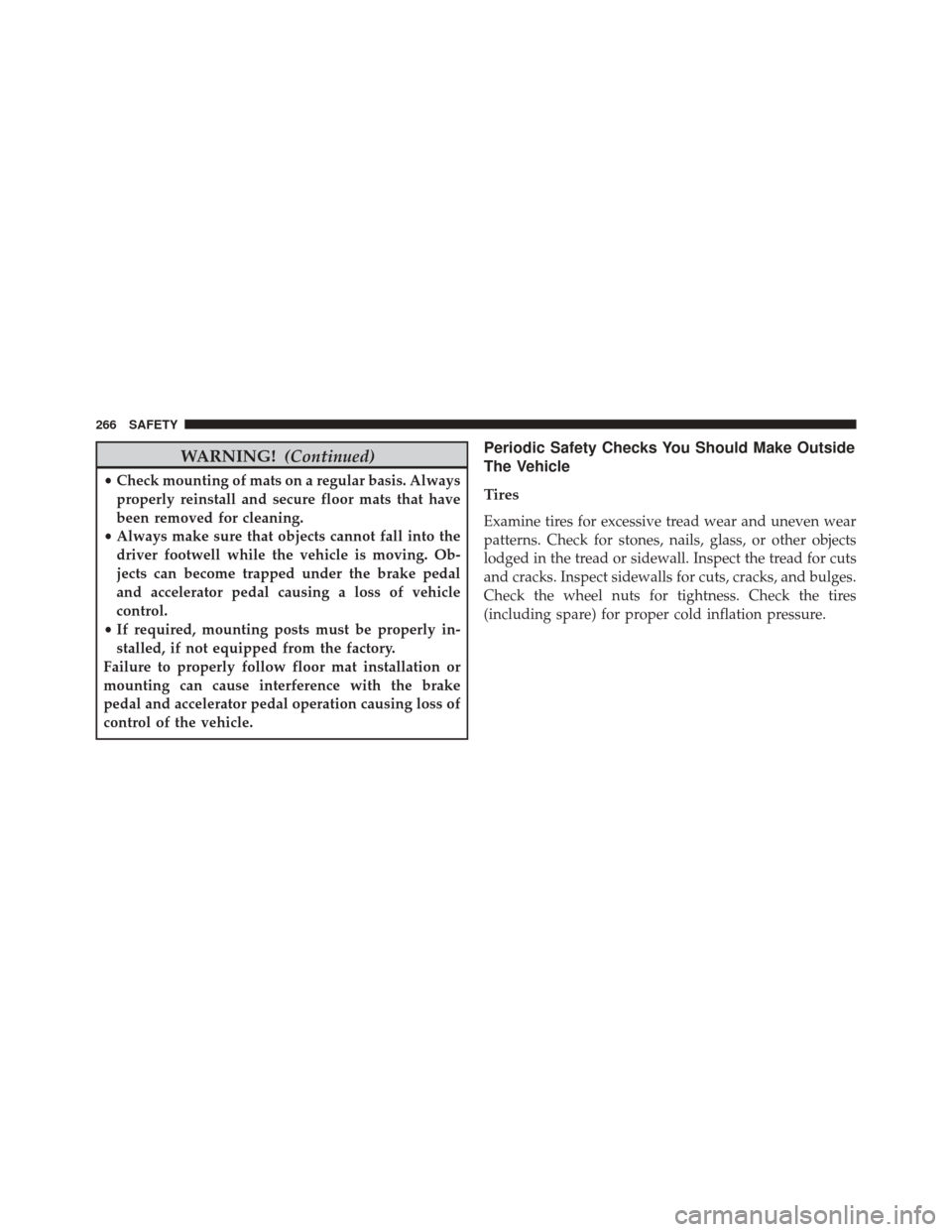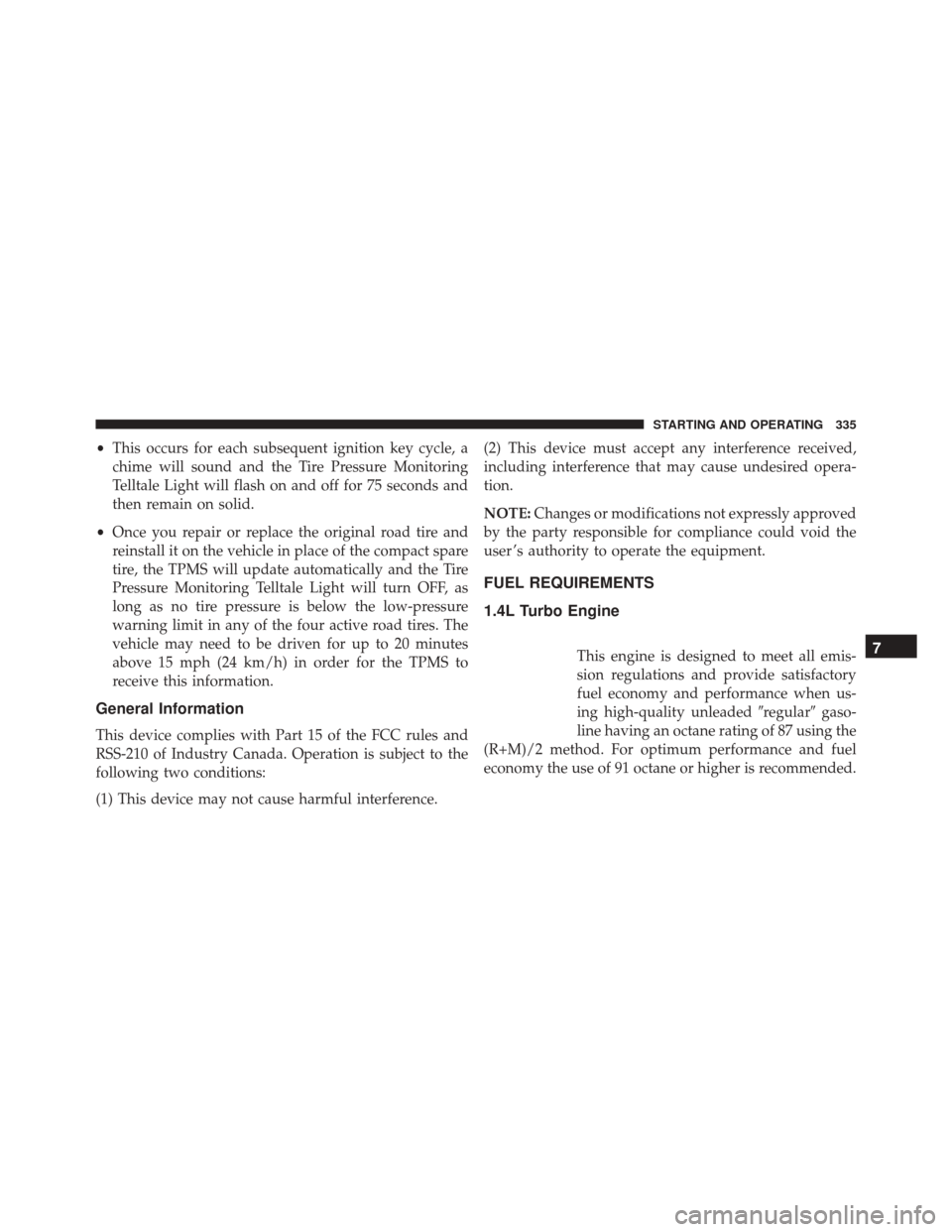Page 145 of 587
Displacement Load Floor
To position the load from the lower to the upper position,
proceed as follows:
1. Grasp the load floor handle and lift up the load floor.
2. Correctly place the load floor on the side panel guidesand on the rear cross member.
Access To Tire Service Kit Or Spare Tire
To access the Tire Service Kit or spare tire and container
carrier, proceed as follows:
1. Grasp the load floor handle and remove the floor.
2. Pull the tab and lift up on the carpet.
Anchoring Of The Load
The cargo tie-downs, located on the trim panels around
the cargo area floor, should be used to safely secure loads
when the vehicle is moving.
Cargo Box — If Equipped
The cargo area contains a preformed cargo box that can
be used for the storage of objects that allows you to
obtain a uniform level when loading.
Tie-Downs
4
GETTING TO KNOW YOUR VEHICLE 143
Page 182 of 587

Anti-Lock Brake (ABS) System Failure•What Does It Mean
By placing the ignition in the MAR/RUN
position, the indicator light illuminates but
should go out after a few seconds.
The light will remain on until the ABS
condition has been corrected. If the prob-
lem is related to the brake booster, the ABS
pump will run when applying the brake, and a brake
pedal pulsation may be felt during each stop.
The display shows the dedicated message.
• What To Do
Please contact your authorized dealer as soon as
possible. TPMS Failure
•What Does It Mean
Each tire, including the spare (if provided),
should be checked monthly when cold and
inflated to the inflation pressure recom-
mended by the vehicle manufacturer on the
vehicle placard or tire inflation pressure
label. (If your vehicle has tires of a different
size than the size indicated on the vehicle placard or
tire inflation pressure label, you should determine the
proper tire inflation pressure for those tires.)
As an added safety feature, your vehicle has been
equipped with a Tire Pressure Monitoring System
(TPMS) that illuminates a low tire pressure telltale
when one or more of your tires is significantly
under-inflated. Accordingly, when the low tire pres-
sure telltale illuminates, you should stop and check
your tires as soon as possible, and inflate them to the
Amber
Warning LightAmber
Warning Light
180 GETTING TO KNOW YOUR INSTRUMENT CLUSTER
Page 268 of 587

WARNING!(Continued)
•Check mounting of mats on a regular basis. Always
properly reinstall and secure floor mats that have
been removed for cleaning.
• Always make sure that objects cannot fall into the
driver footwell while the vehicle is moving. Ob-
jects can become trapped under the brake pedal
and accelerator pedal causing a loss of vehicle
control.
• If required, mounting posts must be properly in-
stalled, if not equipped from the factory.
Failure to properly follow floor mat installation or
mounting can cause interference with the brake
pedal and accelerator pedal operation causing loss of
control of the vehicle.
Periodic Safety Checks You Should Make Outside
The Vehicle
Tires
Examine tires for excessive tread wear and uneven wear
patterns. Check for stones, nails, glass, or other objects
lodged in the tread or sidewall. Inspect the tread for cuts
and cracks. Inspect sidewalls for cuts, cracks, and bulges.
Check the wheel nuts for tightness. Check the tires
(including spare) for proper cold inflation pressure.
266 SAFETY
Page 336 of 587

the “Service Tire Pressure Monitoring System” text mes-
sage will display. If the ignition key is cycled, this
sequence will repeat providing the system fault still
exists. The Tire Pressure Monitoring Telltale Light will
turn off when the fault condition no longer exists. A
system fault can occur with any of the following sce-
narios:
•Jamming due to electronic devices or driving next to
facilities emitting the same radio frequencies as the
TPM sensors.
• Installing some form of aftermarket window tinting
that affects radio wave signals.
• Snow or ice around the wheels or wheel housings.
• Using tire chains on the vehicle.
• Using wheels/tires not equipped with TPM sensors. NOTE:
Your vehicle may be equipped with a compact
spare wheel and tire assembly.
• The compact spare tire does not have a tire pressure
monitoring sensor. Therefore, the TPMS will not moni-
tor the tire pressure in the compact spare tire.
• If you install the compact spare tire in place of a road
tire that has a pressure below the low-pressure warn-
ing limit, upon the next ignition key cycle, a chime will
sound and the Tire Pressure Monitoring Telltale Light
will still turn ON due to the low tire.
• However, after driving the vehicle for up to 20 minutes
above 15 mph (24 km/h), the Tire Pressure Monitoring
Telltale Light will flash on and off for 75 seconds and
then remain on solid.
334 STARTING AND OPERATING
Page 337 of 587

•This occurs for each subsequent ignition key cycle, a
chime will sound and the Tire Pressure Monitoring
Telltale Light will flash on and off for 75 seconds and
then remain on solid.
• Once you repair or replace the original road tire and
reinstall it on the vehicle in place of the compact spare
tire, the TPMS will update automatically and the Tire
Pressure Monitoring Telltale Light will turn OFF, as
long as no tire pressure is below the low-pressure
warning limit in any of the four active road tires. The
vehicle may need to be driven for up to 20 minutes
above 15 mph (24 km/h) in order for the TPMS to
receive this information.
General Information
This device complies with Part 15 of the FCC rules and
RSS-210 of Industry Canada. Operation is subject to the
following two conditions:
(1) This device may not cause harmful interference. (2) This device must accept any interference received,
including interference that may cause undesired opera-
tion.
NOTE:
Changes or modifications not expressly approved
by the party responsible for compliance could void the
user ’s authority to operate the equipment.
FUEL REQUIREMENTS
1.4L Turbo Engine
This engine is designed to meet all emis-
sion regulations and provide satisfactory
fuel economy and performance when us-
ing high-quality unleaded �regular�gaso-
line having an octane rating of 87 using the
(R+M)/2 method. For optimum performance and fuel
economy the use of 91 octane or higher is recommended.7
STARTING AND OPERATING 335
Page 344 of 587
Emergency Refueling Procedure
If the vehicle is out of fuel proceed as follows:
1. Open the liftgate and remove the emergency fuel fillfunnel located in the cargo area.
2. Open the fuel door.
3. Insert the emergency fuel fill funnel in the filler pipeand proceed to fill the fuel tank.
Emergency Fuel Fill Funnel
Emergency Fuel Fill Funnel — If Equipped With Full
Size Spare Tire
342 STARTING AND OPERATING
Page 357 of 587
IN CASE OF EMERGENCY
CONTENTS
�HAZARD WARNING FLASHERS ...........357
� BULB REPLACEMENT ...................357
▫ General Information ....................357
▫ Replacement Bulbs ....................358
▫ Replacing Exterior Bulbs ................360
▫ Replacing Interior Bulbs .................371
� FUSES .............................. .377
▫ General Information ....................378
▫ Access To The Fuses ...................379
▫
Engine Compartment Fuses/Distribution Unit . .379
▫ Body Computer Fuse Center ..............385
▫ Rear Cargo Fuse/Relay Distribution Unit .....388
� JACKING AND TIRE CHANGING ..........390
▫ Jack Location/Spare Tire Stowage — If
Equipped .......................... .391
▫ Preparations For Jacking ................393
▫ Jacking Instructions ...................394
▫ Road Tire Installation ...................400
� TIRE SERVICE KIT STORAGE ..............401
▫ Tire Service Kit — If Equipped ............402
8
Page 393 of 587
Jack Location/Spare Tire Stowage — If Equipped
The jack and tools are located in the rear storage com-
partment if equipped, inside a special container.
1. Open the liftgate.
2. Lift the access cover using the load floor handle.3. Remove the fastener securing the spare tire.
Jack And Tools Location
Load Floor Handle8
IN CASE OF EMERGENCY 391